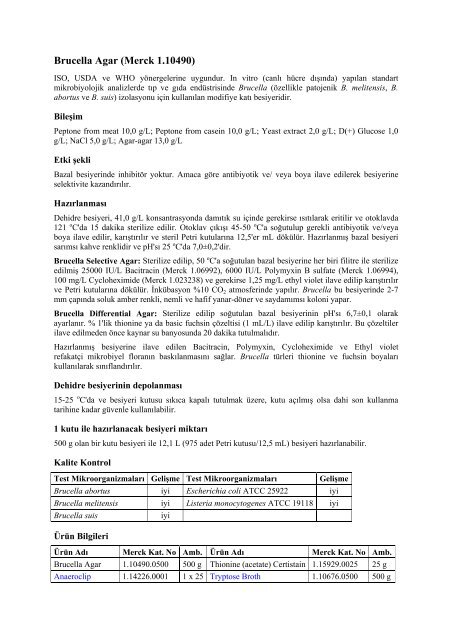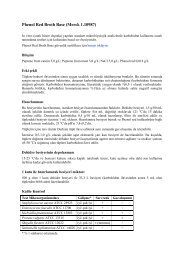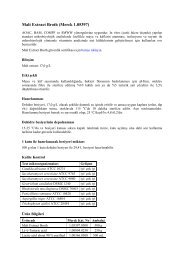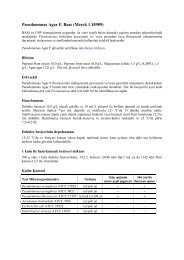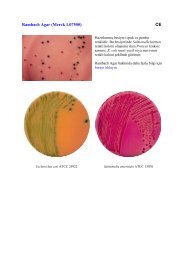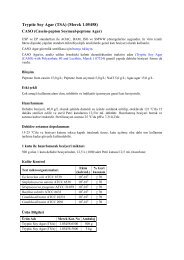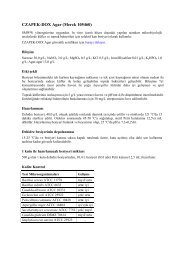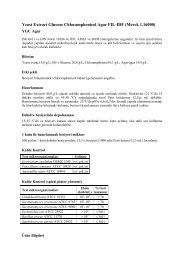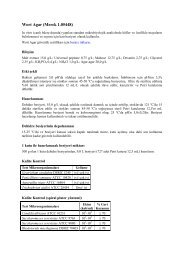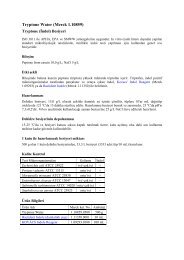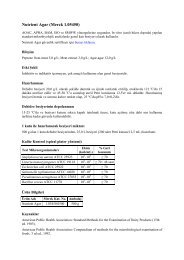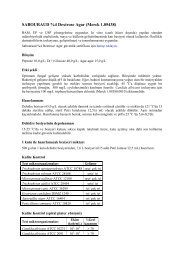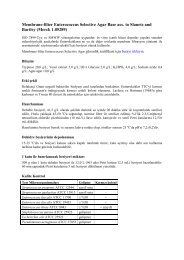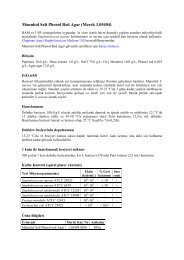Brucella Agar (Merck 1.10490)
Brucella Agar (Merck 1 - mikrobiyoloji.org
Brucella Agar (Merck 1 - mikrobiyoloji.org
- No tags were found...
Create successful ePaper yourself
Turn your PDF publications into a flip-book with our unique Google optimized e-Paper software.
<strong>Brucella</strong> <strong>Agar</strong> (<strong>Merck</strong> <strong>1.10490</strong>)<br />
ISO, USDA ve WHO yönergelerine uygundur. In vitro (canlı hücre dışında) yapılan standart<br />
mikrobiyolojik analizlerde tıp ve gıda endüstrisinde <strong>Brucella</strong> (özellikle patojenik B. melitensis, B.<br />
abortus ve B. suis) izolasyonu için kullanılan modifiye katı besiyeridir.<br />
Bileşim<br />
Peptone from meat 10,0 g/L; Peptone from casein 10,0 g/L; Yeast extract 2,0 g/L; D(+) Glucose 1,0<br />
g/L; NaCl 5,0 g/L; <strong>Agar</strong>-agar 13,0 g/L<br />
Etki şekli<br />
Bazal besiyerinde inhibitör yoktur. Amaca göre antibiyotik ve/ veya boya ilave edilerek besiyerine<br />
selektivite kazandırılır.<br />
Hazırlanması<br />
Dehidre besiyeri, 41,0 g/L konsantrasyonda damıtık su içinde gerekirse ısıtılarak eritilir ve otoklavda<br />
121 o C'da 15 dakika sterilize edilir. Otoklav çıkışı 45-50 o C'a soğutulup gerekli antibiyotik ve/veya<br />
boya ilave edilir, karıştırılır ve steril Petri kutularına 12,5'er mL dökülür. Hazırlanmış bazal besiyeri<br />
sarımsı kahve renklidir ve pH'sı 25 o C'da 7,0±0,2'dir.<br />
<strong>Brucella</strong> Selective <strong>Agar</strong>: Sterilize edilip, 50 o C'a soğutulan bazal besiyerine her biri filitre ile sterilize<br />
edilmiş 25000 IU/L Bacitracin (<strong>Merck</strong> 1.06992), 6000 IU/L Polymyxin B sulfate (<strong>Merck</strong> 1.06994),<br />
100 mg/L Cycloheximide (<strong>Merck</strong> 1.023238) ve gerekirse 1,25 mg/L ethyl violet ilave edilip karıştırılır<br />
ve Petri kutularına dökülür. İnkübasyon %10 CO 2 atmosferinde yapılır. <strong>Brucella</strong> bu besiyerinde 2-7<br />
mm çapında soluk amber renkli, nemli ve hafif yanar-döner ve saydamımsı koloni yapar.<br />
<strong>Brucella</strong> Differential <strong>Agar</strong>: Sterilize edilip soğutulan bazal besiyerinin pH'sı 6,7±0,1 olarak<br />
ayarlanır. % 1'lik thionine ya da basic fuchsin çözeltisi (1 mL/L) ilave edilip karıştırılır. Bu çözeltiler<br />
ilave edilmeden önce kaynar su banyosunda 20 dakika tutulmalıdır.<br />
Hazırlanmış besiyerine ilave edilen Bacitracin, Polymyxin, Cycloheximide ve Ethyl violet<br />
refakatçi mikrobiyel floranın baskılanmasını sağlar. <strong>Brucella</strong> türleri thionine ve fuchsin boyaları<br />
kullanılarak sınıflandırılır.<br />
Dehidre besiyerinin depolanması<br />
15-25 o C'da ve besiyeri kutusu sıkıca kapalı tutulmak üzere, kutu açılmış olsa dahi son kullanma<br />
tarihine kadar güvenle kullanılabilir.<br />
1 kutu ile hazırlanacak besiyeri miktarı<br />
500 g olan bir kutu besiyeri ile 12,1 L (975 adet Petri kutusu/12,5 mL) besiyeri hazırlanabilir.<br />
Kalite Kontrol<br />
Test Mikroorganizmaları Gelişme Test Mikroorganizmaları<br />
Gelişme<br />
<strong>Brucella</strong> abortus iyi Escherichia coli ATCC 25922 iyi<br />
<strong>Brucella</strong> melitensis iyi Listeria monocytogenes ATCC 19118 iyi<br />
<strong>Brucella</strong> suis<br />
Ürün Bilgileri<br />
iyi<br />
Ürün Adı <strong>Merck</strong> Kat. No Amb. Ürün Adı <strong>Merck</strong> Kat. No Amb.<br />
<strong>Brucella</strong> <strong>Agar</strong> <strong>1.10490</strong>.0500 500 g Thionine (acetate) Certistain 1.15929.0025 25 g<br />
Anaeroclip 1.14226.0001 1 x 25 Tryptose Broth 1.10676.0500 500 g
Ürün Adı <strong>Merck</strong> Kat. No Amb. Ürün Adı <strong>Merck</strong> Kat. No Amb.<br />
Anaerocult C 1.16275.0001 1 x 10 Bacitracin CN Biosciences<br />
Anaerocult C mini 1.13682.0001 1 x 25 Polymyxin-B-sulfate CN Biosciences<br />
Kaynaklar<br />
Alton, G.G., a. Jones, L.M.: Laboratory techniques in Brucellosis (WHO, Geneva, 1967)<br />
Cruickshank, J.C.: A Simple Method for Testing Dye Sensitivity of <strong>Brucella</strong> Species. - J. Path. Bact., 60; 328-<br />
329 (1948).<br />
Carrere, L. Renoux, G., et Quatrefages, H.: Apropos de l'action de certaines peptones (Tryptose sur les <strong>Brucella</strong>).<br />
- Ann. Inst. Pasteur, 80. 321-322 (1951)<br />
FAO/WHO: 1. Techn. Rep. Expert Panel on Brucellosis (WHO Techn. Rep. Ser. 37, Genf (1951)).<br />
FAO/WHO: 4. Techn. Rep. Expert Panel on Brucellosis (WHO Techn. Rep. Ser. 289, Genf (1964)).<br />
Hausler, W.J., a. Koonitz, F.P.: Brucellosis (in: Diagnostic Procedures for Bacterial Mycotic and Parasitic<br />
Infections; 5 th ed.; APHA, New York 1970).<br />
Huddleson, I.F.: Brucellosis in man and animals (Commonwealth Fund, New York, 1943).<br />
Jones, L.M., a Wundt, W.: International Committee on Nomenclature of Bacteria, Subcommittee on the<br />
Taxonomy of <strong>Brucella</strong>. - Int. J. Syst. Bacteriol., 21; 126-128 (1971).<br />
Kuzdas, C.D., a. Morse, E.V.: A Selective Medium for the Isolation of <strong>Brucella</strong> from Contaminated Materials. -<br />
J. Bact., 66; 502-504 (1953).<br />
Renoux, G.: Sur un milieu sélectif pour l'isolement de <strong>Brucella</strong> melitensis. - Ann. Inst. Pasteur, 87; 325-333<br />
(1954).<br />
Schuchardt, K.T., Rode, L.J., Oglesby, G., a. Lankford, C.E.: The development of peptone toxicity for <strong>Brucella</strong><br />
with aging and the correlation of this toxicity with the probable oxidation of cystine. - J. Bact., 60; 655-660<br />
(1950).<br />
Spink, W.W.: The Nature of Brucellosis. (Univ. Minnesota Press., Minneapolis, USA, 1956).<br />
Weed, L.A.: The use of a selective medium for isolation of <strong>Brucella</strong> from contaminated surgical specimens. -<br />
Amer. J. Clin. Path., 27; 482-485 (1957).<br />
Wundt, W.: Untersuchungen zur Entwicklung leistungsfähiger Brucellennährböden. - Zbl. Bakt. I. Orig., 169;<br />
393-402 (1957)<br />
Wundt, W.: Untersuchungen über die Eignung von Peptonen zur Prüfung der Schwefelwasserstoffbildung von<br />
Brucellen. - Zeitschr. f. Hyg., 144; 425-435 (1958). Baird-Parker, A.C.: An improved diagnostic and selective<br />
medium for isolating coagulase positive Staphylococci. - J. Appl. Bact., 25; 12-19 (1962).<br />
DIN Deutsches Institut für Normung e.V.: Nachweis Koagulase-positiver Staphylokokken. Referenzverfahren für<br />
Milchpulver. - DIN 10178.<br />
DIN Deutsches Institut für Normung e.V.: Nachweis Koagulase-positiver Staphylokokken. Referenzverfahren für<br />
Milchpulver. - DIN 10163.<br />
European Pharmacopeia II, Chapter VII, 10.<br />
Internationaler Milchwirtschaftsverband; Nachweis Koagulase-positiver Staphylokokken in Milchpulver<br />
(Referenzmethode). - Internationaler Standard 60 A (1978).<br />
ISO International Organization for Standardization: Dried milk-Enumeration of Staphylococcus aureus. Colony<br />
count technique. - Draft Proposal ISO/PP 8869 (1984).<br />
ISO International Organization for Standardization: Meat and meat products - Detection and enumeration of<br />
Staphylococcus aureus (Reference methods). - Draft International Standard ISO/DIS 5551 (1977).<br />
Niskanen, A., a. Aalto, M.: Comparison of selective media for coagulase-positive enterotoxigenic<br />
Staphylococcus aureus. - Appl Envir. Microbiol., 35; 1233-1236 (1978)<br />
Smith, B.A., a. Baird-Parker, A.C.: The use of sulfamethazine for inhibiting Proteus spp. on Baird-Parker's<br />
isolation medium for Staphylococcus aureus. - J. Appl. Bact., 27 78-82 (1964).<br />
Stadhouders, J., Hassings, F., a. Van Aalsten-Van Maren, N.O.: A pour-plate method for the detection and<br />
enumeration of coagulase-positive Staphylococcus aureus in the Baird-Parker Medium without egg-yolk. - Netz.<br />
Milk Diary J., 30; 222-229 (1976)<br />
United States Pharmacopeia XXIII, Chapter "Microbial limit Tests", 1995.


